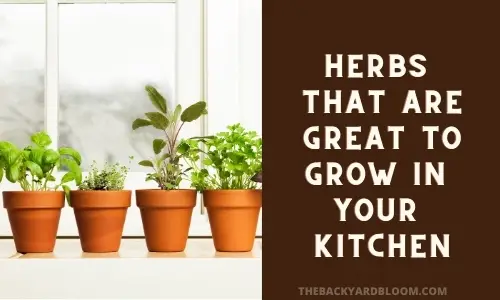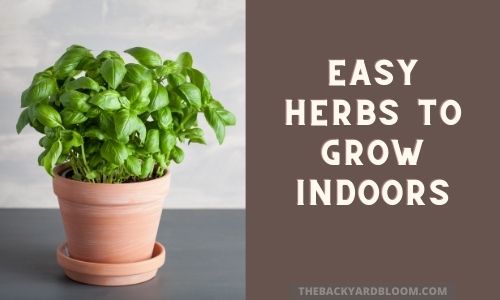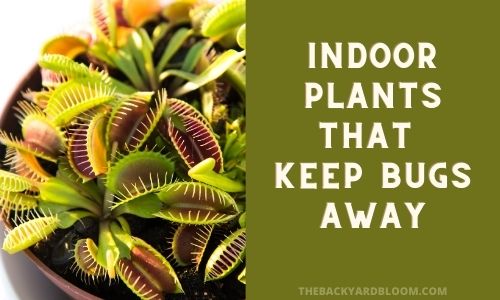Please note that this post may contain affiliate links. You can read my full affiliate disclosure at the bottom of the page.
Basil is one of those easy-to-grow herbs that takes a good recipe and turns it into the perfect pairing of flavors. It is one of the more popular herbs used and grown in the kitchen.
Growing fresh basil is easy to do as it grows well in most conditions (except for cold climates). And basil has a wonderful flavor and aroma no matter if you choose to grow your basil inside or outside in a garden.
Why Should You Grow Basil?
Benefits Of Growing Basil
- Save Money
- Get Truly Fresh Basil
- Get Access to More Varieties of Basil
- Basil is an Easy to Grow Herb
- Cut Down On Pesticides and Chemicals
- It Helps Other Plants In Your Garden
Well for starters, you can grow basil to help save money. If you find yourself often having to visit the store to buy a small pack of fresh basil, why not just grow it and save yourself the money and the hassle?
Another benefit of growing basil is that you are sure you have fresh basil. Sure the stuff you buy from the store in the produce sections says fresh. But really, how fresh can something be that had to get picked, go through a packaging process from who knows where then travel to your grocery store? When you grow basil on your own, no matter if it’s on your kitchen windowsill or out in your vegetable garden, you know how fresh that basil is.
If you grow your own basil, you can grow any variety of basil that you want. There is more than just one kind of basil. So growing basil allows you to get experimental with your recipes that use basil. There are various varieties of basil that you can easily get seeds to grow: Sweet Basil, Genovese Basil, Opal Basil, Lemon Basil, and Italian Leaf Basil are just a few of the many options. You can also get Thai Basil (also called Siam Queen Basil) which is great in Southeast Asian dishes.
Basil is one of those herbs that grow easily. So if you aren’t exactly the best at gardening, basil will make it easy on you. You can grow basil indoors and outdoors. So regardless of your current gardening situation, if you have a full-blown backyard garden, or just a windowsill or small apartment balcony you can grow your own basil.
You can even get a small hydroponics growing system and grow basil like crazy inside with the iDOO Hydroponics Growing System:

Let’s face it, commercial growing uses chemicals. No matter how much we may not like it, anything you buy from the grocery store in the produce section has stuff dumped on it that might make you want to scream if you knew what exactly was in it. All of these chemicals are taken up into the plant and you’re eating that. Talk about yuck. I myself am highly sensitive to things like glyphosate and other chemicals, so any opportunity I can get to avoid eating something that has been doused in who knows what I’ll take.
Basil is also a great companion plant for tomatoes. It will help keep insects away from your tomato plants and helps with the flavor of the tomatoes growing on your plants. Companion planting is a great tool to use in your garden and basil is one of the easy-to-use herbs for companion planting. You can even put it in a pot with your tomato plant if you are growing tomatoes in containers. Other garden vegetables and herbs that basil is a great companion plant for are beans, beets, eggplant, peppers, chives, and potatoes.
Growing Basil – The Basics
Basil is an easy-to-grow herb that doesn’t require too much beyond some good soil that is well-drained, some sunlight (or grow light), and water. You can even grow his herb from scraps you have leftover from another plant.
If you’ve never done anything with gardening before, basil isn’t anything that is going to make it hard for you.
The main thing you will find with growing basil is that it requires more water than other herbs do.
But you can make things a bit easier with a hydroponics herb garden kit. This comes with a LED grow light and a water circulation system for your plants, you just need to get the seeds (you can even use it for other herbs if you want.)
Basil is great for growing indoors in a pot or using hydroponics, and it is also easy to grow in the garden.
You can grow basil from seed or if you prefer you can always pick up a young basil plant from your local garden shop.
The Basic Necessities for Growing Basil from Seed:
If growing from seed you will want a good potting mix for starting seeds. You can make your own seed starting mix. Or you can buy some premixed like Espoma Organic Seed Starter Potting Mix. You will also need some seed starter trays if you plan on transplanting your seedlings. And of course, you will need your basil seeds.
You will want to make sure you water your seedlings enough to keep the soil moist.
The other essential thing you will need for your basil seeds to start growing is sunlight. Basil does best with at least 6 hours of sunlight each day.
LED Light Options for Growing Basil:
If you don’t have a nice sunny place, then LED grow lights are always an option. There are several I have used over the last few years that have given me great results. These will also give you several options on how to set up your light depending on the area you are going to use to place the seedlings:
I had one setup on my desk that I just used a full spectrum LED bulb in place of the normal light bulb in the desk lamp using this:
Full Spectrum LED Plant Light Bulb

I used this full spectrum LED light panel by hanging it from underneath a cabinet for growing some seedlings prior to our first frost:
LED Grow Light Full Spectrum Panel

This grow light I used for seedlings I had on a shelf that didn’t have many options for hanging a LED grow light panel or setting up a lamp. This LED grow light allowed me to clip the light onto the shelf itself and then position the 3 grow lights how I needed. And even better with this one is that it has a timer built in so I can set it up to come on and go off how I need it without any hassle.
Clipon LED Grow Light

Growing Basil Outdoors from Seed
If you want to grow basil outside in your garden, then you are in luck, it is easy to do.
I’ve even had luck going the super lazy route and just throwing the seed down and putting some soil on top of those seeds, add water and let nature go.
Of course, if you go this route you want to make sure to pull out some of the basil plants that germinate.
Basil can grow up to 2 feet in height and you want your basil plants to be at least 12 inches apart.
You will also want to determine the type of basil you want to grow as there are many different types of basil plants.
Basil Seeds
This one might be a given. But just in the interest of making sure everything is covered here, you will need basil seeds.

Soil
Just like with growing basil indoors, when growing basil outdoors you want to make sure that you have good quality soil that is well-drained.
I always make sure to add compost to my garden soil. This way I can add good quality nutrients that my garden plants can use. You can either buy compost or make your own. My preference is to make compost using a compost tumbler.
If you are using raised beds you can use potting soil or raised bed soil mixed with compost.
Sunlight
Basil needs at least 6 hours of sunlight.
It is best to plant your basil in a place where it can get the first part of the day’s sun.
Try to avoid letting the midday sun beat down on your basil plants. If you are companion planting then usually the bigger plants like tomatoes will shade your basil from the harsh midday sun.
Water
In the garden you basil will require frequent watering.
It is usually best to make sure you don’t let the soil dry out. If this happens then your basil plants can start losing their color and fragrance.
You want to make sure to water the basil plant around the base of the plant. Watering the leaves can attract unwanted pests and help promote disease.
Companion Plants For Basil
Basil is a great herb to use when companion planting. It can help repel unwanted bugs and helps your other plants gain more flavor and thrive.
Best Companion Plants For Basil In The Garden:
- Tomatoes
- Potatoes
- Chili Peppers
- Bell Peppers
- Oregano
- Eggplant
- Marigolds
- Asparagus
- Petunias
- Grapes
- Chamomile
Growing Basil Indoor From Seed
When growing basil in containers indoors it’s a fairly straightforward process.
If growing your basil in a pot, you don’t have to worry about having a big container. Flower pots as small as 4 inches will do fine for an indoor basil plant.
You will want a high-quality potting mix that is well-drained, along with a sunny windowsill that gets at least 6 hours of sunlight. Usually, a southern-facing window is best. Or if you don’t have that available, an LED grow light can provide all the light you will need.
You will also want to use an organic fertilizer to help your basil keep getting the nutrients it needs while it’s growing.
Watering your basil plant will need to be done frequently. You will want to make sure that the soil is kept moist. Just make sure you don’t have the soil soaking wet.
Misting your indoor basil plant regularly is a good idea too. And like when growing basil outside, water your plant at the base of the basil plant.
Another option for growing basil indoors is a hydroponics herb garden system. These help you grow herbs fast and save a ton of hassle. You get all the light you need with these systems as they come with a full spectrum LED grow light attached.
Moving Indoor Basil Outside
If you want to move seedlings that you started inside to your outdoor garden or balcony then you will need to harden off your seedlings.
To complete the process of getting your indoor basil to tolerate the harsh light of the sun you need to slowly introduce it to direct sunlight.
One way to do this is to start putting the basil plant outside for about 20 minutes and increasing the time it stays outside in direct sunlight each day a bit. This way usually takes me about 2 full weeks to get the plant fully used to outdoor life.
Another way to transfer basil outside is to make sure you are past your last frost date. Once you are sure it won’t be frosting outside anymore pick 3 days where it is going to be overcast the whole time. This is the easiest and fastest technique that I have used to harden off any of my plants. Using this technique I don’t have to keep track of the amount of time the plant is outside or make sure I remember to bring the plant back in.
Growing Basil from Cuttings
Basil is one of those very hardy plants that will sprout roots easily from cuttings.
Trimming your basil plant should be a regular thing you do. Basil responds well when you prune it.
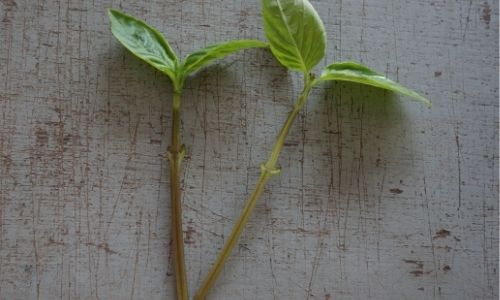
So if you find yourself not needing the basil leaves that you just took off, keep them attached to the stem. Take the leaves near the bottom off (allowing for at least 2 inches of the stem) and then stick these in a glass of water.
Another trick people use when propagating basil from cuttings is to use rooting hormone. To use this take a moist paper towel and wrap it around your freshly cut stems. After they’re moist take the paper towel off and dip it into the rooting hormone. Make sure to tap any access off then put the cuttings in the glass of water.
Put your basil cuttings in a sunny spot or under a grow light in the glass of water.
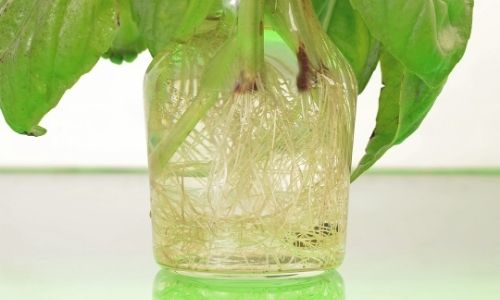
You will want to change out the water every other day. And in about 10 to 14 days you should have roots growing. Once there’s a good root system, about 2 inches long, you can plant your new basil plant in a pot or start the process of transferring it outside.
Harvesting Basil
Harvesting your basil is also known as pruning basil.
To harvest the fresh basil that you’ve grown, cut back the basil stems just above where an intersection where the plant has side shoots coming out. You do not want to leave a long branch or even a stub above your basil plant’s intersections.
You can either use what you cut off for cooking. Dry it out to save for later. Or make a stem cutting to grow roots so you can get another basil plant.
